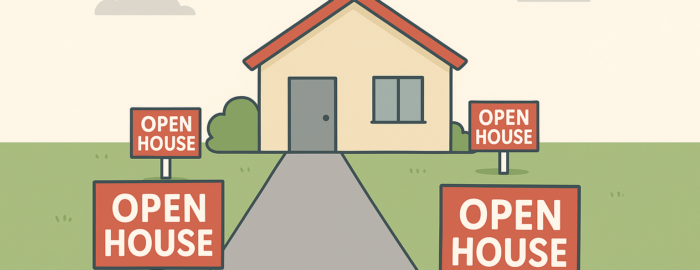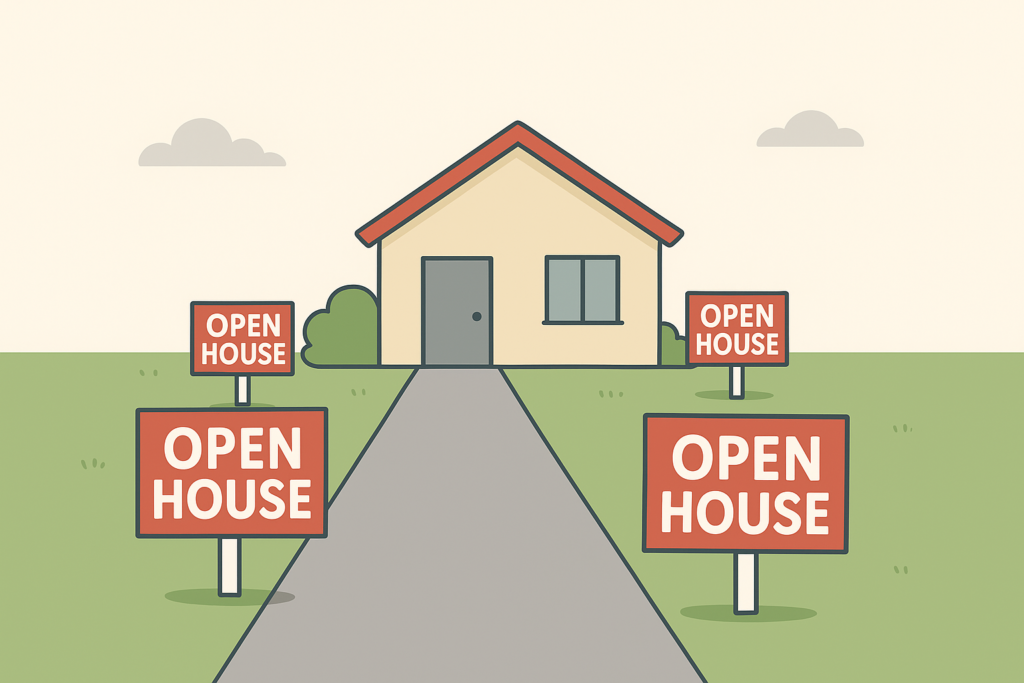Open houses are a classic real estate tradition. They provide a convenient, no-appointment needed way for curious neighbors, passers-by, and prospective buyers to tour a property. They feel tangible and hopeful for sellers: “someone might just fall in love with it this weekend.” But increasingly, data and buyer behavior show that open houses are rarely the path by which most homes are sold—and in many cases, they’re more of a perk than the core strategy. Below are the trends, statistics, and underlying reasons why open houses may not be your best investment.
What the Data Tells Us
- Low percentage of sales originate via open houses
According to the National Association of REALTORS (NAR), only about 3% of buyers say their first step in the homebuying process was attending an open house. (HomeGo)
Another recent summary puts the figure of buyers who found their purchased home through open house signs, yard signs, or an open house itself at approximately 5%. (propertysalesgroup.com) - Most home shoppers begin online and with agents
The same NAR research indicates that looking online is now the most common first step: roughly 40-45% of buyers begin their search on a real estate site. (Nar Realtor)
Contacting a real estate agent directly is another frequent early move. Many serious buyers are already represented and are seeing listings via their agent or through MLS, before even attending any open houses. (Nar Realtor) - Attending open houses happens—but mostly as exploratory/secondary behavior
While very few buyers start their search with an open house, many do visit one or more open houses during the search process. It seems to serve more as a way to compare, get a feel for neighborhoods, and see properties up close after narrowing down via online or agent-curated selection. (Nar Realtor) - Changing buyer expectations & tools
Online tools—high-quality photos, video tours, 3D walkthroughs, drone shots, detailed floor plans—give buyers far more information up front. Agents can show multiple homes via private showings, often more targeted and efficient than open houses. Buyers increasingly expect to preview homes virtually first, then only physically tour those that pass muster. (HomeGo)
Why Open Houses Often Fall Short for Sellers
Understanding the data is one thing; knowing why open houses underperform helps set strategy. Here are the main factors:
- Many attendees are not serious buyers. A lot of the foot traffic at open houses comes from neighbors, people comparing homes, professionals in real estate, or browsers just “window-shopping.” These visitors may provide some visibility, but they rarely produce offers. (HomeGo)
- First impressions made online. Buyers often reject or shortlist homes based on online content before stepping inside. Bad photos, poor staging, or an unflattering floor plan often mean many potential buyers never even consider an open house. Strong online presence can be far more decisive. (Nar Realtor)
- Scheduling and convenience issues. Open houses happen on fixed days/times. Serious buyers with busy schedules or buyers out of town prefer private showings that can be arranged at mutually convenient times. Open houses don’t always align. (HomeGo)
- Cost vs return in effort. Preparing for an open house (cleanup, staging, being off premises part of the day, etc.) takes time and effort. If it doesn’t lead to serious leads or offers, the ROI may be weak compared to investing in online marketing, enhanced photography, virtual tours, etc. (HomeGo)
- Safety & privacy concerns. Some sellers worry about security with many unknown visitors entering the home. Privacy concerns, item safety, etc. are more visible risks for public, open‐house events. (phixer.net)
When Open Houses Might Make Sense
That said, open houses are not without value in certain situations. They are still part of the toolbox—not the only tool. Here are cases where an open house can help:
- If the home is competitively priced and well-staged, an open house can generate buzz, especially in areas with decent foot traffic or strong local buyer interest.
- For sellers who are early in the process and want maximum visibility, open houses can help draw eyeballs, perhaps draw in people who have been casually looking but haven’t yet committed.
- For agents, open houses are a lead-generation tool: visitors may later become clients or may refer friends/family. Even if someone doesn’t buy this home, they might buy another—or help spread the word.
- When inventory is thin, nothing kills momentum like being seen. Open houses can help position a listing in the public eye in markets where comparable inventory is lower.
Modern Buyer Behavior: What’s Really Driving Sales
To really understand why open houses are less central today, consider how modern buyers work:
- Online first, always. Nearly every buyer uses the internet in their home search—often weeks before they ever see a house in person. They scroll, filter, watch video tours, view floor plans, check neighborhood data, commute times, school ratings. (Nar Realtor)
- Private showings over browsing. Serious buyers tend to work with agents who show them homes personally (often homes they picked online), not rely on public-open house weekends. Private showings are more efficient and targeted.
- Comparison shopping vs urgency. In cooler or balanced markets, homes may stay on the market longer. Sellers hoping for a quick buyer from an open house may find offers delayed or weak if buyers are taking their time.
- Use of virtual tools. Virtual walkthroughs, video tours, and digital marketing allow buyers to vet homes more thoroughly up front, so when they do visit in person, expectations are higher—and they’ve likely decided whether to move forward or not.
What Sellers Should Consider Instead
Given the trends and data, here are some steps sellers (and agents) should consider to maximize their chances:
- Invest in digital marketing & high-quality visuals. Good photos, virtual tours, well-crafted listing descriptions draw more eyes.
- Price properly from the start. Overpricing tends to deaden interest, no matter how many people walk through in person.
- Schedule private showings for serious prospects. Let your agent filter and pre-qualify so that you spend time with people who are ready, rather than hoping a random visitor will become a buyer.
- Use open house as supplemental tool, not centerpiece. If you do an open house, promote it heavily online, treat it as an event, stage well, and use it to collect leads. But don’t expect it to be the primary source of your buyer.
- Maximize agent network and MLS exposure. Often, other agents bring their buyers; having broad and strong listing exposure matters more than walk-in traffic.
Conclusion
Open houses still have a place in real estate marketing—they offer exposure, possible lead generation, and sometimes casual buyer interest. But the statistics are clear: very few buyers begin with an open house, and even fewer find their home primarily through one. Most buyers today do the heavy lifting online first, work with agents, tour with intent via private showings, and finally make decisions based on a curated shortlist of homes.
If you’re selling a property in North Seattle (King & Snohomish Counties), you’ll want a strategy built around what works in 2025: stellar online presentation, accurate pricing, and targeted showings. Open houses can be part of that mix—but should never be your entire plan.
If you’re thinking about selling—or want to hear what marketing paths are likely to perform well in your neighborhood—Grant Team Properties at RE/MAX Elite is ready to build the right strategy for your listing. We’ll help you get the visibility, showings, and buyer fit that actually lead to offers in Snohomish and King County, Washington.


